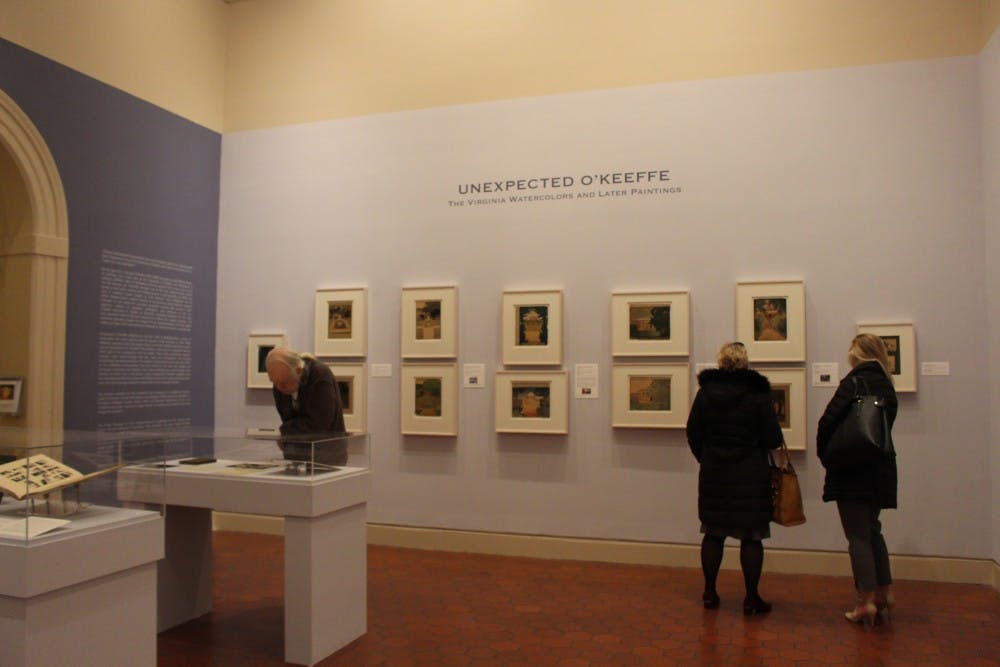“This is O’Keeffe geekdom … if that’s not your deal, this is the time to leave!” Carolyn Kastner, Curator Emerita of the Georgia O’Keeffe Museum in Santa Fe, N.M., joked at the beginning of her talk. The crowd that gathered in Campbell Hall Nov. 15 for the annual Gladys S. Blizzard Lecture, “Learning to See Abstractly,” seemed eager to absorb the knowledge Kastner would share about the artist, particularly her time at the University.
Matthew McLendon, director of the Fralin Museum of Art, introduced Kastner to the crowd. He spoke to his excitement for the currently running exhibit at the Fralin, “Unexpected O’Keeffe: The Virginia Watercolors and Later Paintings,” and the evening’s speaker, who would emphasize the importance of continued scholarship of O’Keeffe’s early work and watercolors.
Throughout her talk, Kastner reiterated the importance of O’Keeffe’s disciplined practice, reminding the crowd with visual examples of her work over the span of a 60-year career. Evaluating her student work and then moving forward in time — through her teaching career in Texas, her work in New York at Lake George and her practice in New Mexico — Kastner told a story of O’Keeffe’s journey as an artist and her devotion to the principles she established while in Charlottesville.
“She’s not finding a shape — I say she’s defining a shape,” Kastner said, prompting the audience to look deeper at O’Keeffe’s art compared to the nature she took inspiration from.
She elaborated that O’Keeffe’s early drawings and watercolors, though less popular than her paintings of enlarged flowers which gained her worldwide renown, have an educative capacity to teach others how to see and study her work.
“I want you to see them the way I see them,” Kastner said of the paintings she displayed in front of the audience, “as radical experiments that set the course for her future.”
O’Keeffe transformed a natural scene by isolating its parts and reassembling with her own methods. Kastner described it as the artist relaying “her ideas of what she observed,” rather than mere reproduction. This practice of interpretation and transformation would continue, with O’Keeffe always beginning with line, questioning her own work and guiding her work through what Kastner called “the path of abstraction.”
As her career continued, O’Keeffe continued to shape her process, which she adapted from the compositional work of Arthur Wesley Dow. Before coming to the University, O’Keeffe went four years without making any art, an experience she described as a “trauma” but about which scholars know little.
Kastner said that being at the University “ended the doubts about being an artist that had haunted [O’Keeffe],” allowing her to find her voice as an artist and start building a professional career in Texas as head of the art department at West Texas State Normal College in 1916.
From there, O’Keeffe embarked on a similar journey as many of her modernist contemporaries — she wanted to make “the great American thing.” Kastner described her attempts to build on her art, escaping from subjective painting to instead embrace the particularities of the countryside, “visually articulating an individual experience.”
Kastner also repeatedly spoke about her wish for the University to continue uncovering the mysteries of O’Keeffe’s practice and life as an artist through newly-discovered letters and archives.
“I can’t express how important it is for a field that seemed closed … when we go into the archive, we’re finding a different story,” Kastner said.
In “Learning to See Abstractly,” Kastner educated an eager crowd on the role the University played in a young Georgia O’Keeffe’s life. She also emphasized the job scholars at the University should embrace today in using their environment and resources to tell more of O’Keeffe’s story. Her influence, Kastner said, is all around.
“When you [know where to look], you see it everywhere.”
Visitors can explore O’Keeffe’s environmental artistry fully through the new exhibit at the Fralin. Located comfortably in one room on the second floor of the museum, “Unexpected O’Keeffe” presents the artist’s work as a student alongside paintings from her later life, illustrating the longevity of the disciplined practice O’Keeffe adopted while at the University. Guests can also see Dow’s “Book of Composition,” on display — the guide which shaped O’Keeffe’s studious devotion to line as the beginning of any composition.
The exhibition’s high potential for scholarly importance — which McLendon emphasized at the beginning of Kastner’s talk — is undeniable, but “Unexpected O’Keeffe” also instills in the visitor a kind of wonder. Examining O’Keeffe’s series of watercolors depicting the Rotunda, a sense of pride emerges that a young artist could come to Charlottesville, reignite her passion after a period of immense self-doubt, adopt a lifelong practice and — instead of painting what was already right in front of her — craft something from nature, yet entirely new.
“Unexpected O’Keeffe” will be on display through Jan. 27, 2019.







